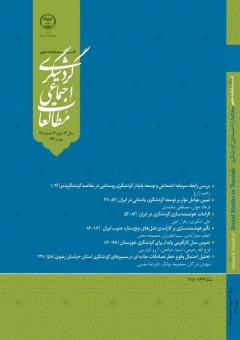تبیین عوامل مؤثر بر توسعه گردشگری یادمانی در ایران
محورهای موضوعی : مطالعات اجتماعی و گردشگری، جامعه شناسی گردشگری
1 - استادیار گروه مدیریت جهانگردی، دانشکدۀ میراث فرهنگی، صنایعدستی و گردشگری، دانشگاه مازندران، بابلسر، ایران
2 - دانشیار مدیریت جهانگردی، گروه صنایعدستی، دانشکده هنر و معماری، دانشگاه مازندران، بابلسر، ایران.
کلید واژه: توسعه گردشگری, گردشگری یادمانی, ایران,
چکیده مقاله :
پژوهش حاضر با هدف تبیین عوامل مؤثر بر توسعه گردشگری یادمانی در ایران انجام شده است، در این راستا؛ از نظر هدف، کاربردی و از لحاظ روش در گروه پژوهشهای کیفی و کمی قرار دارد. به منظور تجزیه و تحلیل اطلاعات از مدل تئوری زمینهای و آراس فازی استفاده شده است. جامعه آماری در پژوهش حاضر نیز شامل متخصصان و نخبگان در حوزه مطالعاتی (گردشگری) است، که با استفاده از روش نمونهگیری هدفمند صورت گرفت و تعداد 35 نفر انتخاب شدند. نتایج نشان داد، بسترهای علی از جمله: خدمات و امکانات زیرساختی، تبلیغات مناسب، اطلاعرسانی، تقویت در مشارکت جامعه میزبان، شناسایی قابلیتهای مناطق جنگ زده، تغییر در نگرش نسبت به جنگ و توجه خاص به گردشگری جنگ در اقتصاد، بسترهای زمینهای: افزایش در نیروهای متخصص، مشارکت نهادهای دولتی و غیردولتی، تقویت در امنیت، افزایش در توسعه خدمات، تقویت در سیمای بصری موزهها و دوری از رهیافت صرفا فرهنگی، بسترهای مداخلهگر: همکاری و انسجام بین سازمانها، مدیریت مطلوب، تقویت مدیریت واحد، کاهش دوگانگی در انجام خدمات، کاهش رویکرد متمرکز در بین سازمانها و تهیه طرح جامع، استخراج شد. سپس به بررسی موانع و پیامدهای حاصل از توسعه گردشگری یادمانی، در ایران پرداخته شد، و در نهایت راهکارهای تدوین چشمانداز مطلوب از گردشگری جنگ در ایران، تقویت در مدیریت یکپارچه، تنظیم یک برنامه تفضیلی به منظور شناساندن سایتهای گردشگری دفاع مقدس، ترویج برنامههای آموزشی، هماندیشی بین متخصصان، کارشناسان و مدیران سازمانهای مرتبط شناسایی شدند.
This applied mixed-method study sought to elaborate on the factors affecting the development of memorial tourism in Iran. To this end, the Grounded Theory model and fuzzy ARAS method were used to analyze the collected data. The statistical population of the study comprised specialists and elites in the field of study (tourism), out of whom thirty-five individuals were selected through purposive. According to the findings of the study, the causal factors included infrastructure services and facilities, appropriate advertising, properly informing the public information, promoting participation in the host community, identifying the capabilities of war-torn areas, changing attitudes towards war, and special attention to war tourism in the economy; contextual factors included increasing specialized forces, participation of governmental and non-governmental institutions, improving security, increasing service development, improving the visual appearance of museums and avoiding a purely cultural approach; interventionist factors included promotion of cooperation and cohesion between organizations, optimal management, developing unified management, attempting to avoid dual standards in service delivery, reducing the application of the centralized approach among organizations and preparing a comprehensive plan. Then, the obstacles and consequences of the development of memorial tourism in Iran were examined, and finally, the ways to develop a desirable vision of memorial tourism in Iran, developing integrated management, setting a detailed plan to introduce the holy defense tourism sites, promoting educational programs, and consultation among experts, experts and managers of related organizations were identified.
